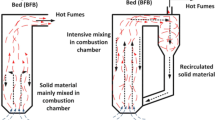Abstract
A computational fluid dynamics (CFD) model was developed to study the temperature profile of the bun during baking process. Evaporation-condensation mechanism and effect of the latent heat during phase change of water was incorporated in this model to represent actual bun baking process. Simulation results were validated with experimental measurements of bun temperature at two different positions. Baking process is completed within 20 min, after the temperature of crumb become stable at 98 °C. Further, this study was extended to investigate the effect of partially (two baking trays) loaded and fully loaded (eight baking trays) oven on temperature profile of bun. Velocity and temperature profile differs in partially loaded and fully loaded oven. Bun placed in top rack showed rapid baking while bun placed in bottom rack showed slower baking due to uneven temperature distribution in the oven. Hence, placement of bun inside the oven affects temperature of bun and consequently, the quality of the product.










Similar content being viewed by others
References
Anishaparvin A, Chhanwal N, Indrani D, Raghavarao KSMS, Anandharamakrishnan C (2010) An investigation of bread baking process in a pilot-scale electrical heating oven using computational fluid dynamics. J Food Sci 75:E605–E611
Chhanwal N, Anishaparvin A, Indrani D, Raghavarao KSMS, Anandharamakrishnan C (2010) Computational fluid dynamics (CFD) modeling of an electrical heating oven for bread-baking process. J Food Eng 100:452–460
Chhanwal N, Indrani D, Raghavarao KSMS, Anandharamakrishnan C (2011) Computational fluid dynamics modeling of bread baking process. Food Res Int 44:978–983
Chhanwal N, Tank A, Raghavarao KSMS, Anandharamakrishnan C (2012) Computational fluid dynamics (CFD) modeling for bread baking process-A review. Food Bioprocess Technol 5:1157–1172
Hamdami N, Monteau JY, Le Bail A (2004) Heat and mass transfer in par-baked bread during freezing. Food Res Int 37:477–488
Incropera (2006) Fundamentals of heat and mass transfer, 6th edn. Wiley, New York
Kuriakose R, Anandharamakrishnan C (2010) Computational fluid dynamics (CFD) applications in spray drying of food products. Trends Food Sci Technol 21:383–398
Martin PJ, Chin NL, Campbell GM (2004) Aeration during bread dough mixing ii. A population balance model of aeration. Food Bioprod Process 82:268–281
Mills ENC, Wilde PJ, Salt LJ, Skeggs P (2003) Bubble formation and stabilization in bread dough. Trans IChemE Part C Food Bioprod Process 81:189–193
Mondal A, Datta AK (2010) Two-dimensional CFD modeling and simulation of crustless bread baking process. J Food Eng 99:166–174
Purlis E, Salvadori VO (2009) Bread baking as a moving boundary problem. Part 2: model validation and numerical simulation. J Food Eng 91:434–442
Purlis E, Salvadori VO (2010) A moving boundary problem in a food material undergoing volume change – simulation of bread baking. Food Res Int 43:949–958
Sun DW (2007) Computational fluid dynamics in food processing. CRC Press, Boca Raton
Therdthai N, Zhou W, Adamczak T (2003) Two dimensional CFD modeling and simulation of an industrial continuous bread baking oven. J Food Eng 60:211–217
Therdthai N, Zhou W, Adamczak T (2004) Three-dimensional CFD modeling and simulation of the temperature profiles and airflow patterns during a continuous industrial baking process. J Food Eng 65:599–608
Thorvaldsson K, Janestad H (1999) A model for simultaneous heat, water and vapour diffusion. J Food Eng 40:167–172
Wagner MJ, Lucas T, Le Ray D, Trystram G (2007) Water transport in bread during baking. J Food Eng 78:1167–1173
Wong SY, Zhou W, Hua J (2006) Robustness analysis of CFD model to the uncertainties in its physical properties for a bread baking process. J Food Eng 77:784–791
Wong SY, Zhou W, Hua J (2007) CFD modeling of an industrial continuous bread-baking process involving U-movement. J Food Eng 78:888–896
Zanoni B, Peri C, Gianotti R (1995) Determination of the thermal diffusivity of bread as a function of porosity. J Food Eng 26:497–510
Zhou W, Therdthai N (2007) Three-dimensional modeling of a continuous industrial baking process. In: Sun DW (ed) Computational fluid dynamics in food processing. CRC Press, Boca Raton, pp 287–312
Acknowledgments
We wish to acknowledge the Department of Science and Technology (DST), Government of India for the financial support for this work. Authors also acknowledge the CSIR for the financial support through Network project (NWP-02) for Ansys 12 software licensing.
Author information
Authors and Affiliations
Corresponding author
Rights and permissions
About this article
Cite this article
Tank, A., Chhanwal, N., Indrani, D. et al. Computational fluid dynamics modeling of bun baking process under different oven load conditions. J Food Sci Technol 51, 2030–2037 (2014). https://doi.org/10.1007/s13197-012-0736-6
Revised:
Accepted:
Published:
Issue Date:
DOI: https://doi.org/10.1007/s13197-012-0736-6




